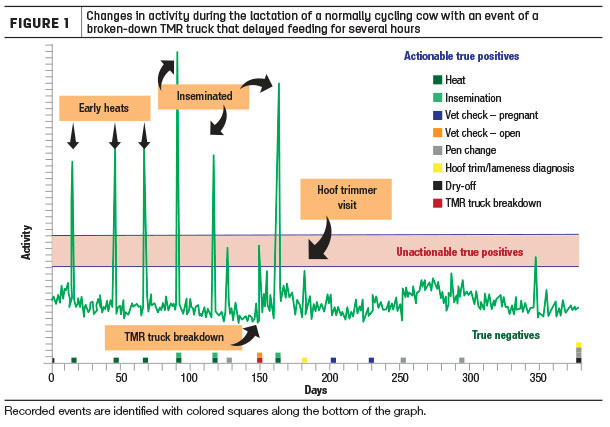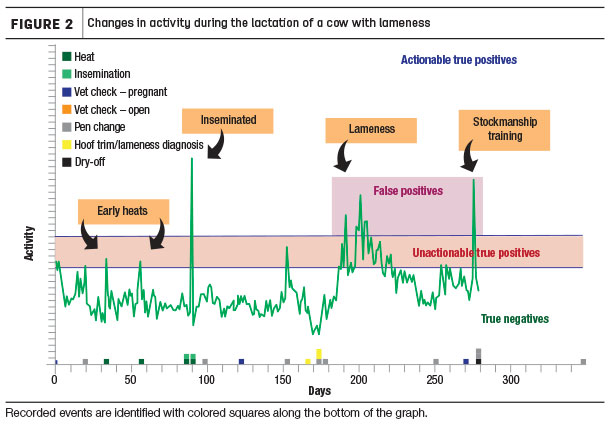I learned a long time ago that “frustration comes from expectation,” and this is a prime example. When a dairy farmer invests in a “heat detection” system, they expect it to do exactly that – to detect heats. So when the system flags animals that are not in heat, frustration ensues.
In just the last couple of years, we have seen an explosion of commercially available options for heat detection in cattle. Most of the systems are based on activity measurements; it doesn’t matter if the technology is on the leg as a pedometer, on the neck as a collar, on the ear as an eartag, or inside the cow as a rumen bolus. These systems objectively measure all activity of the cow wearing it, and it is up to us humans to determine what that activity means.
Research shows us that, when a cow is in heat, she will substantially increase her activity because her estrogen levels have increased. That’s why activity is a good indicator of heat. The problem is that heat is not the only situation during which a cow increases activity, and these situations happen every day on a farm, leading to “false positives” in heat detection. Here are some of the other situations:
- Pen moves, not just of that cow, but of other cows into her pen (new interactions)
- Lameness, especially at the beginning of the disease, or in case of injuries, the first thing they do is shake that leg or tiptoe, which translates into increased activity, especially in cows wearing pedometers, and especially if they become lame on the leg wearing the pedometer
- Other cows in heat in the pen, especially with synchronization protocols
- Nutritional problems, such as hot rations or not delivering enough feed or on time (the cows are walking around looking for something to eat, see Figure 1)
- Accidents, just like with lameness, unless the cow is down, the first sign is an increase in activity
- Faulty tags

Instead of seeing these systems as only heat detection systems, it would be best to look at them as “alarms” that something is different. The interpretation of what is different and what that means is still part of the art of dairying. For example, consider the cow in Figure 2. There are several times during her lactation in which her activity surpassed the limit of detection, and she was flagged with high activity. Those in the green area are “true negatives,” indicating nothing was different enough to trigger an alarm. Those events above the green area are indicative that something is different, and the data needs to be evaluated. This doesn’t necessarily mean we have to go find the cow.

If we have accurate event recording, we can glean valuable information to determine whether we need to do something or not. In the orange area are good alarms (“true positives” that something was different) that we know are not actionable for us to go inseminate the cow, but they are correct in that something is different: early heats with lower activity, pen changes and a lameness event. We can use these alarms to monitor and improve management. For example, the early heats with low activity tell us this cow was not as healthy as she should have been. Healthy cows show heats with high activity deviations, even early on in lactation like the cow in Figure 1.
The large deviation in activity around 190 days in milk (DIM) for the cow in Figure 2 also shows us this cow was lame and needed attention. The fact this happened after visiting the hoof trimmer for her annual trim tells us she may have been overtrimmed. So you can also evaluate hoof trimmer performance with an activity monitoring system.
The pen changes around 20, 100 and 250 DIM do not show increased activity, which tells us it is definitely possible to change pens without altering cow activity. This has been consistently observed in farms that have activity monitoring systems. However, the pen changes happening around 150 DIM and 280 DIM show very large deviations. This tells us the cow handling in those two pen moves is different and needs to be re-evaluated.
When the outgoing pen is close to the milking parlor, and the receiving pen is far away, you will see an increase in activity, but it rarely triggers a correctly set alarm level, and it stays constant after the initial increase. Given that it is best to inseminate later in the estrus event, waiting to see if the activity stays constant would not be detrimental to conception. In an earlier article, I showed how waiting until activity decreases results in higher conception.
More recent research is showing us there are other objectively measured changes during the time when a cow is in heat, such as lower milk production, lower rumination time, lower resting time and increased temperature. Although this new information improves the accuracy of existing heat detection systems by combining activity with another variable, it is not free of the pitfalls mentioned before: A lame cow, for example, can have higher activity, lower milk and higher temperature. The point is, the alarm is accurate in that there is something different about that cow, and she needs to be evaluated, either on the computer (looking at her data and what the potential problem is) or in person.
So you think you purchased only a heat detection system, and what you really got was a herd management tool that can help monitor multiple aspects of your farm, including nutrition and animal handling. ![]()
PHOTO: Staff photo.

-
Aurora Villarroel
- Veterinarian
- Athyr Vet LLC
- Email Aurora Villarroel






